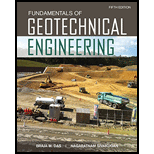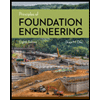
(a)
Whether the statement “A key is provided at the base of a cantilever retaining wall to improve the stability with respect to overturning” is true or false.
(a)
Answer to Problem 15.1P
The given statement is
Explanation of Solution
Actually a key is provided to increase the passive resistance at the toe which will increase the factor of safety against sliding. Hence, the base key will improve the stability of wall with respect to sliding.
Therefore, the given statement is
(b)
Whether the statement “The earth pressure distribution beneath the base of the retaining wall is uniform” is true or false.
(b)
Answer to Problem 15.1P
The given statement is
Explanation of Solution
The distribution of earth pressure below the base slab is not uniform because,
- Different earth pressure exerts on the base slab.
- The base slab is not a homogeneous one (concrete has homogeneous property).
- The friction between soil and base slab can distribute the earth pressure that is non-uniform in nature.
Therefore, the given statement is
(c)
Whether the statement “The lateral earth pressures in active state are greater in loose sands than in dense sands” is true or false.
(c)
Answer to Problem 15.1P
The given statement is
Explanation of Solution
- Active lateral earth pressure is the tilting of wall away from the position.
- The chance of tilting is more in loose sands compared to dense sands. Hence, the lateral earth pressures in active state are greater in loose sands than in dense sands.
Therefore, the given statement is
(d)
Whether the statement “A base heave problem is more serious in soft clays than in stiff clays” is true or false.
(d)
Answer to Problem 15.1P
The given statement is
Explanation of Solution
- Braced cuts in clay may become unstable due to the formation of heaving at the bottom of the excavation.
- Heave is the upward movement of the ground due to the expansion of clay, which swells when wet.
- More expansion will lead to heave. The expansion of soft clay is more compared to stiff clay. Hence, the base heave problem is more serious in soft clays than in stiff clays.
Therefore, the given statement is
(e)
Whether the statement “Cantilever sheet piles have to be driven deeper in loose sands than in dense sands” is true or false.
(e)
Answer to Problem 15.1P
The given statement is
Explanation of Solution
- The reason to drive sheet piles at a certain depth below the bottom excavation is to reduce the lateral yielding of wall during the last stages of excavation.
- The lateral yielding in the loose sands is greater than the dense sands. Hence, the cantilever sheet piles have to be driven deeper in loose sands than in dense sands. The deeper piles will reduce the lateral yielding.
Therefore, the given statement is
Want to see more full solutions like this?
Chapter 15 Solutions
Fundamentals of Geotechnical Engineering (MindTap Course List)
- A rigid retaining wall 5m high supports a backfill of cohesionless soil with angle of 40°. The water table is below the base of the wall. The backfill is dry and has a unit weight of 19kN/m³. Determine Rankine's passive earth pressure per meter length of the wall.arrow_forwardA retaining wall 7 m high, with its back face smooth and vertical. It retains sand with its surface horizontal. Using Rankine’s theory, determine the active earth pressure at the base when the backfill is dry. Take γ=18 kN/m^3 ,ϕ=30°, γ_sat=21 kN/m^3.arrow_forwardQ.5 A retaining wall has a vertical back and is 7.32 m high. The soil is sandy loam of unit weight 17.3kN/m3. It has a cohesion of 12 kN/m2 and Ø = 20°. Neglecting wall friction, determine the active thrust on the wall. The upper surface of the fill is horizontal.arrow_forward
- Assuming the retaining wall shown below is pushed to the right by an external force, calculate the passive lateral earth pressure coefficient assuming that the wall friction is equal to 18o. Assume that the backfill is under drained conditions and the water table is below the base of the retaining wall.arrow_forwardCalculate the passive earth pressure coefficient for the foundation soil to the right of thetoe of the wall using the Rankine Earth Pressure theory. On Figure 1, sketch the passivepressure distribution and calculate the resultant force(s). Show the resultant, and itslocation, on your sketch.AND Sketch the wall and the distribution of lateral earth pressures resulting from the backfillfor the Coulomb case, assuming good drainage. Call this “Figure 2: Coulomb Active EarthPressures from Backfill.” Calculate the resultant horizontal and vertical forces and addthem to your sketch. Indicate clearly the location of the resultant forces.arrow_forwardA retaining wall with vertical back is 8 m. high. The density of top 3 m. of fill is 1.75 Mg/m³ and the angle of internal friction is 30°. For the lower 5 m. the values are 1.85 Mg/m³ and 35° respectively. There is a surcharge load on the horizontal surface of the fill equivalent to 1.2 Mg/m² uniformly distributed. Solve for the following questions below: 1. Find the magnitude of the thrust on the wall per linear meter if the fill is well drained. 2. Find the magnitude of the thrust on the wall per linear meter if the fill is waterlogged after a storm (Assume the saturated quantities of the two strata are 1.9 and 2.0 Mg/m³ respectively.) 3. Find the point of application of 5 points the thrust on the wall if the fill is waterlogged after a storm.arrow_forward
- A retaining wall supports a horizontal backfill that is composed of two types of soil. First layer: 4.27 meters high, Unit weight of 17.25 kN/m3, coefficient of active pressure of 0.286 Second layer: 6.27 meters high, Unit weight of 18.27 kN/m3, coefficient of active pressure of 0.309 Determine the distance of the total active force measured from the bottom of the wall. Round off to three decimal places.arrow_forwarda retaining wall supports a horizontal backfill that is composed of two types of soil. first layer: 4.92 meters high, Unit weight of 16.29 kN/m^3, coefficient of active pressure of 0.296 second: 6.85 meters high, Unit weight of 18.31 kN/m^3, coefficient of active pressure of 0.302 determine the distance of the total active force measured from the bottom of the wallarrow_forwardDetermine the active Rankine earth pressure (magnitude and location) against the 1-foot thick retaining wall in the figure at right.arrow_forward
- A retaining wall 8 m high supports cohesionless soil having a dry density of 1600 kg/m³, angle of resistance 33° and void ratio of 0.60. The surface of the soil is horizontal and level with the top of the wall. Neglecting wall friction and using Rankine’s formula for active pressure of a cohesionless soil. 1.Determine the nearest value of the total earth thrust on the wall in KN per lineal meter if the soil is dry. 2. Find the nearest value of the thrust on the wall in KN per lineal meter if owing to inadequate drainage, it is waterlogged to a level of 3.5 m below the surface? 3. Find at what height above the base of the wall the thrust acts during the waterlogged condition?arrow_forwardFor the retaining wall shown in the figure, compute the factors of safety against overturning and sliding (analyze the latter both with and without passive earth pressure at the toe). Also determine the soil pressure at the base of the wall. Use the Rankine equation to compute passive earth pressure.arrow_forwardA retaining wall 7 m high supports a cohesionless soil having a dry density of 1600 kg/m3, the angle of shearing resistance is 33° and void ratio of 0.68. The surface of the soil is horizontal and level with the top of the wall. Neglect wall friction and use Rankine’s formula for active pressure of a cohesionless soil. Determine the nearest value of the total earth thrust on the wall in kN per lineal meter if the soil is dry. Determine the nearest value to the thrust on the wall in kN per lineal meter if owing to inadequate drainage, it is water logged to a level 3 m below the surface. Determine the nearest value to the height above the base of the wall where the thrust acts during the waterlogged condition.arrow_forward
 Fundamentals of Geotechnical Engineering (MindTap...Civil EngineeringISBN:9781305635180Author:Braja M. Das, Nagaratnam SivakuganPublisher:Cengage Learning
Fundamentals of Geotechnical Engineering (MindTap...Civil EngineeringISBN:9781305635180Author:Braja M. Das, Nagaratnam SivakuganPublisher:Cengage Learning Principles of Foundation Engineering (MindTap Cou...Civil EngineeringISBN:9781305081550Author:Braja M. DasPublisher:Cengage Learning
Principles of Foundation Engineering (MindTap Cou...Civil EngineeringISBN:9781305081550Author:Braja M. DasPublisher:Cengage Learning Principles of Foundation Engineering (MindTap Cou...Civil EngineeringISBN:9781337705028Author:Braja M. Das, Nagaratnam SivakuganPublisher:Cengage Learning
Principles of Foundation Engineering (MindTap Cou...Civil EngineeringISBN:9781337705028Author:Braja M. Das, Nagaratnam SivakuganPublisher:Cengage Learning


